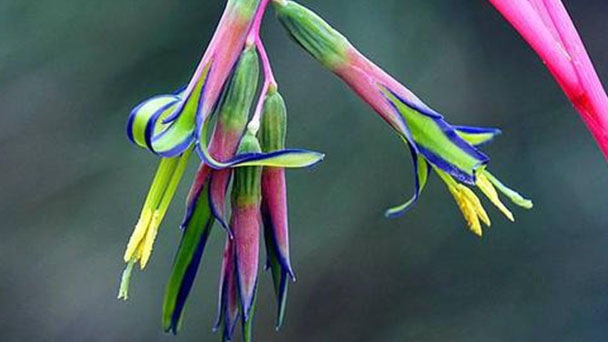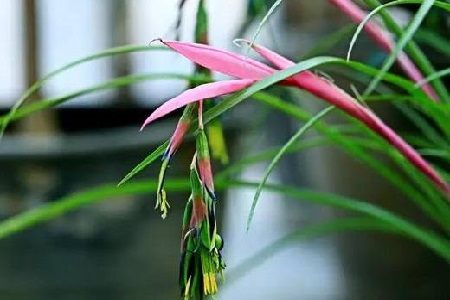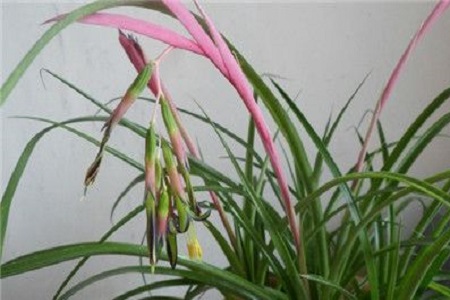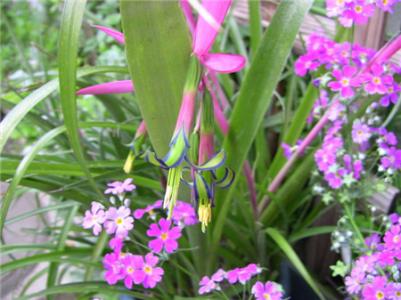Queen's tears (Billbergia nutans) profile
Written by Maggie
Mar 22 2021

Queen's Tears (Billbergia nutans) is a perennial evergreen herb of the genus Aqua in the bromeliad family. Queen's Tears is a small bromeliad, often clustered with multiple plants. The plant is a rosette, composed of 12 to 15 leaves.
Queen's Tears (Billbergia nutans) originated in South America. Leaves are sword-shaped, hard, with fine teeth. Inflorescences are long, spicate, with several large rose-red bracts. Queen's tears has cold resistance, can withstand the low temperature of 2℃ for a short time. Generally, plants that have been cultivated for 3 years or have a diameter of more than 8 cm will blossom and bear fruit. Seeds can be collected for sowing and reproduction, and the emergence rate is high. It is easy to manage the young stage and is suitable for potted ornamental.
Queen's tears picture

Morphological characteristics of queen's tears
Queen's Tears has a very short stem. Leaves are rose-shaped caespitose, 50 cm long and 15 mm wide, apex pendulous, leaf margin with sparsely spiny; Scape is 30 cm long, apex pendulous, with flowers 4-12, glabrous, inflorescence rachis geniculate; Involucral bracts are narrow, appressed to scapes, pink to reddish; Queen's tears has 3 calyx, 1.3-2.7 cm long, orange-red, margin blue-purple, petals 3, 3.6-4 cm long, green, margin blue-purple, apex acute, reflexed; Queen's tears has 6 stamens; Anthers are 7 mm long, extruding from flowers; Ovary is inferior, green, 1 cm long, axial placenta, stigma torsion. Seeds are mostly small.
China's greenhouse is often cultivated for ornamental.
Queen's tears are a perennial evergreen herb in the genus Aqua of Bromeliads. It is a small bromeliads, often clustered with multiple plants. The plant is a rosette, composed of 12 to 15 leaves. Leaves are sword-shaped or narrowly lanceolate, hard, dark green, abaxially covered with white scales, powdery, margin slightly serrated. Spring-flowering, scapes drawn from leaves, spikes arched and pendulous, ca. 30 cm long, bracts rose-red, corolla yellow-green, margin blue.
Ecological Habits of queen's tears
Queen's Tears is relatively cold resistant and can withstand the low temperature of 2℃ for a short time.
How to grow and care for queen's tears
(1) Temperature
Queen's tears like warm climate, the suitable temperature for growth is 21~27° in the ornamental pineapple belonging to the kind of strong adaptability to temperature, can withstand the low temperature of 2~5°. In South China, it can overwinter on open ground, but in the north of China, it is necessary to move indoors to keep warm, and cover the plants with plastic bags when the cold current attacks to prevent the occurrence of cold damage. We should strengthen ventilation in the hot summer season, driving away the sultry weather.
(2) Light
Queen's tears like half shade, avoid strong sunlight exposure. When the light is too strong, the leaf will turn yellow and even the leaf burns and coke spots. From spring to autumn, the ship will be shaded to cover 50% to 70% of the light, or place with sufficient light. The rest of the year requires plenty of sunshine.
(3) Watering
Queen's tears like wet soil conditions, pot soil too dry will make the leaf tip withered and scorched, and poor plant growth. During the growth period should be sufficient to supply water, keep the basin soil moist; But avoid too wet and water, so as not to rot root.
(4) Ambient humidity
Queen's tears like to grow in the environment of high air relative humidity, air relative humidity can best be maintained at 85 degrees. When the relative humidity of the air is large, the plant will appear bright and oily luster.When the air is dry, the plant will become dull and dull, and the leaves are thin and lifeless. During the growth, especially when the air is dry, we should often spray water to the surrounding environment to make the air moist. When the temperature is low in winter, plastic bags can be put on the pot plant, which can not only keep heat, but also maintain appropriate air relative humidity, thus conducive to the growth of plants.
(5) Fertilization
Spring flowering topdressing before 1 ~ 2 time under the | 1 material, can make the big and bold in bloom. After flowering, the Queen's tears does not have high requirements for fertilizer, and generally does not need to apply fertilizer. Only when the plant is weak due to lack of fertilizer, can the nitrogen-based fertilizer be applied appropriately.Stop fertilizing in winter.
(6) Pruning
After the flowers of Queen's tears fade, the flowers should be cut off in time to facilitate the germination of new buds.
(7) Repotting
When the pot is not turned over for many years, Queen's tears are not easy to germinate, and the plant cluster is easy to age, and the growth potential becomes worse. We should every 1~2 years turn over the basin 1 time, turn over the basin should be in the flowering after the line. The substrate can be prepared by 1 part of peat soil, 1 part of vermiculite, 0.5 part of perlite or 1 part of peat soil and 1 part of tree fern.

The propagation of queen's tears
Propagate and divide, sow.
(1) Queen's tears division: after flowering, the cluster plants are divided into several clusters with a sharp knife, combined with turning over the basin.The new plant should not be small,
Each cluster has at least two mother plants and carries one or two daughter plants. The new plants were small and could survive, but they were not beautiful.Smear sulfur powder or plant ash on the wound after cutting, and then put them into the basin separately. The new Queen's tears can flower in the second year after it is planted.
(2) Sowing: Immediately after the fruit is mature, remove the peel and wash the seeds, seed on demand in the matrix, pour enough water and cover the pot with glass or plastic bags, maintain the temperature above 20°, generally 1~2 weeks after germination. Seedlings need to be cultivated for 3 years to blossom, so use less.
Disease control of queen's tears
Generally, there are few pests and diseases. Only in the air relative humidity is low, not ventilated easy to breed red butterflies, scale insect harm.
Cultivation of common problems
1. Leaf tip is scorched: ① the air is too dry;(2) insufficient watering and the basin soil is too dry.
2. Root rot or stem rot: often caused by excessive watering, especially in winter when low temperature and wet waterlogging is more likely to produce.
Queen's tears uses
Garden use
Queen's Tears leaves are like orchids and are beautiful when they bloom.
They have both handsome leaves and handsome flowers, and are strong and easy to grow and raise, suitable for families.
Ornamental and health care function
Queen's Tears is a plant of sedum acid metabolism (CAM). It should be placed in the bedroom or study to keep the indoor air fresh.

Latest Updated
- Benefits of Bugleweed - 7 Science-backed Health Benefits
- Bugleweed Dangers & Side Effects - Is It Poisonous?
- How to Plant Evergreen Trees - What You Should Know
- When to Plant Evergreens - Grow Guide for Evergreen Trees
- 12 Wonderful Evergreen Shrubs for Your Garden
- 12 Popular Evergreen Plants with Pictures for Beginners
- When And How To Prune A Lilac Bush Like a Pro
- How to Grow & Care for Lilac Vine (Hardenbergia Violacea)
- Japanese Lilac Tree (Syringa Reticulata) Care & Propagation Guide
- Shumard Oak Pros and Cons - What to Know
Popular Articles
- Winter maintenance of Antirrhinum Majus
- How to Grow Terminalia Mantaly Tree
- How to Grow and Care for Crossostephium Chinense
- How to grow Antirrhinum Majus in spring
- Peristeria Elata (Dove Orchid) Profile: Info & Care Guide
- Underwatered Snake Plant (Sansevieria Trifasciata) - Signs And How To Fix
- How to Care for Brazilian Jasmine Plant (Mandevilla Sanderi)
- How to Grow & Care for Graptopetalum Purple Delight in Summer
- Rosa Chinensis (China Rose): Plant Growing & Care Tips
- How to Care for Baby Sun Rose (Aptenia Cordifolia)